spark Lexus HS250h 2010 Scheduled Maintenance Guide / LEXUS 2010 HS250H OWNERS MANUAL (OM75006U)
[x] Cancel search | Manufacturer: LEXUS, Model Year: 2010, Model line: HS250h, Model: Lexus HS250h 2010Pages: 608, PDF Size: 9.89 MB
Page 94 of 608
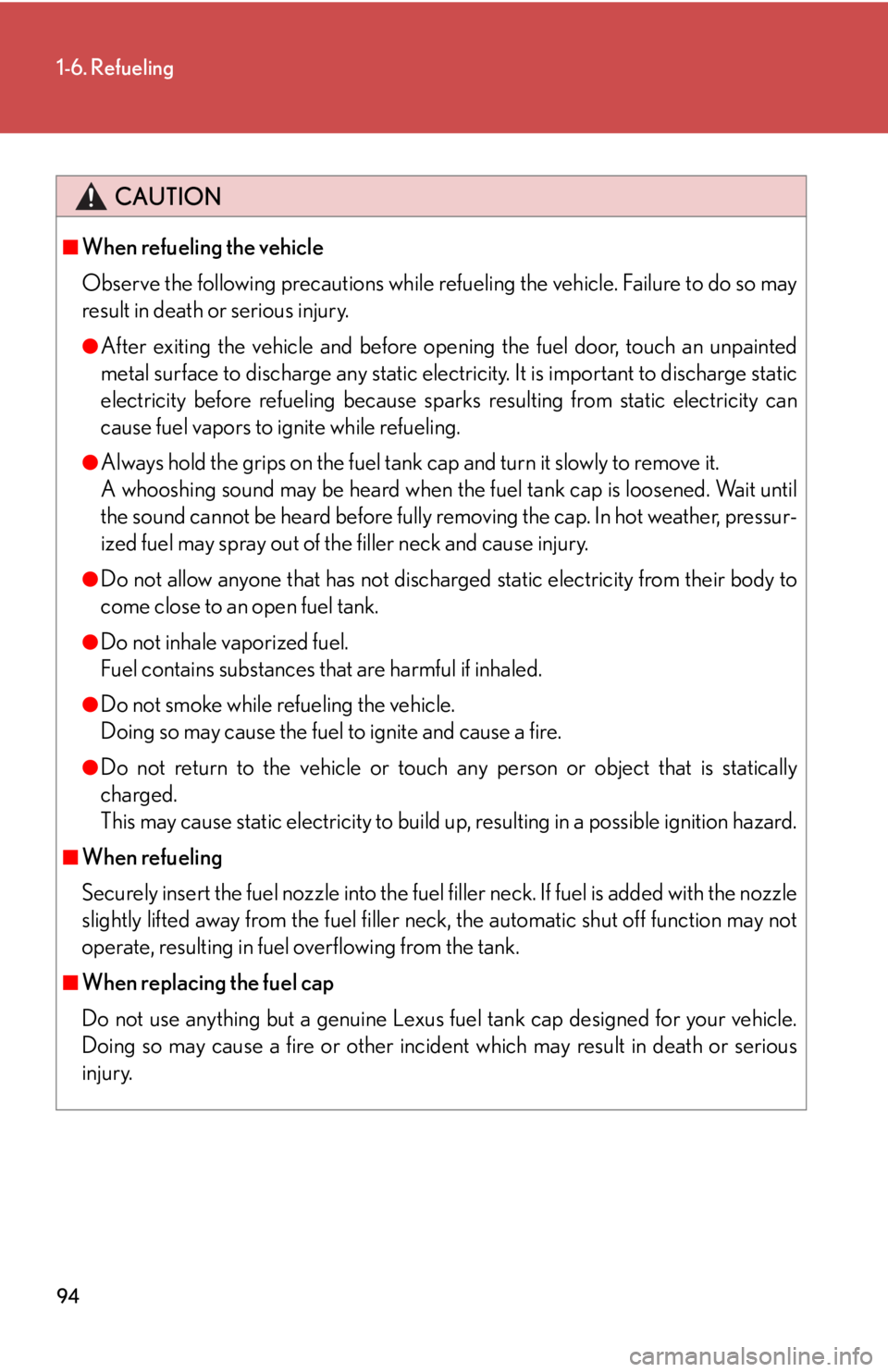
94
1-6. Refueling
CAUTION
■When refueling the vehicle
Observe the following precautions while refueling the vehicle. Failure to do so may
result in death or serious injury.
●After exiting the vehicle and before opening the fuel door, touch an unpainted
metal surface to discharge any static electricity. It is important to discharge static
electricity before refueling because sparks resulting from static electricity can
cause fuel vapors to ignite while refueling.
●Always hold the grips on the fuel tank cap and turn it slowly to remove it.
A whooshing sound may be heard when the fuel tank cap is loosened. Wait until
the sound cannot be heard before fully re moving the cap. In hot weather, pressur-
ized fuel may spray out of the filler neck and cause injury.
●Do not allow anyone that has not discharged static electricity from their body to
come close to an open fuel tank.
●Do not inhale vaporized fuel.
Fuel contains substances that are harmful if inhaled.
●Do not smoke while refueling the vehicle.
Doing so may cause the fuel to ignite and cause a fire.
●Do not return to the vehicle or touch an y person or object that is statically
charged.
This may cause static electricity to build up , resulting in a possible ignition hazard.
■When refueling
Securely insert the fuel nozzle into the fuel filler neck. If fuel is added with the nozzle
slightly lifted away from the fuel filler neck, the automatic shut off function may not
operate, resulting in fuel overflowing from the tank.
■When replacing the fuel cap
Do not use anything but a genuine Lexus fuel tank cap designed for your vehicle.
Doing so may cause a fire or other incident which may result in death or serious
injury.
Page 418 of 608
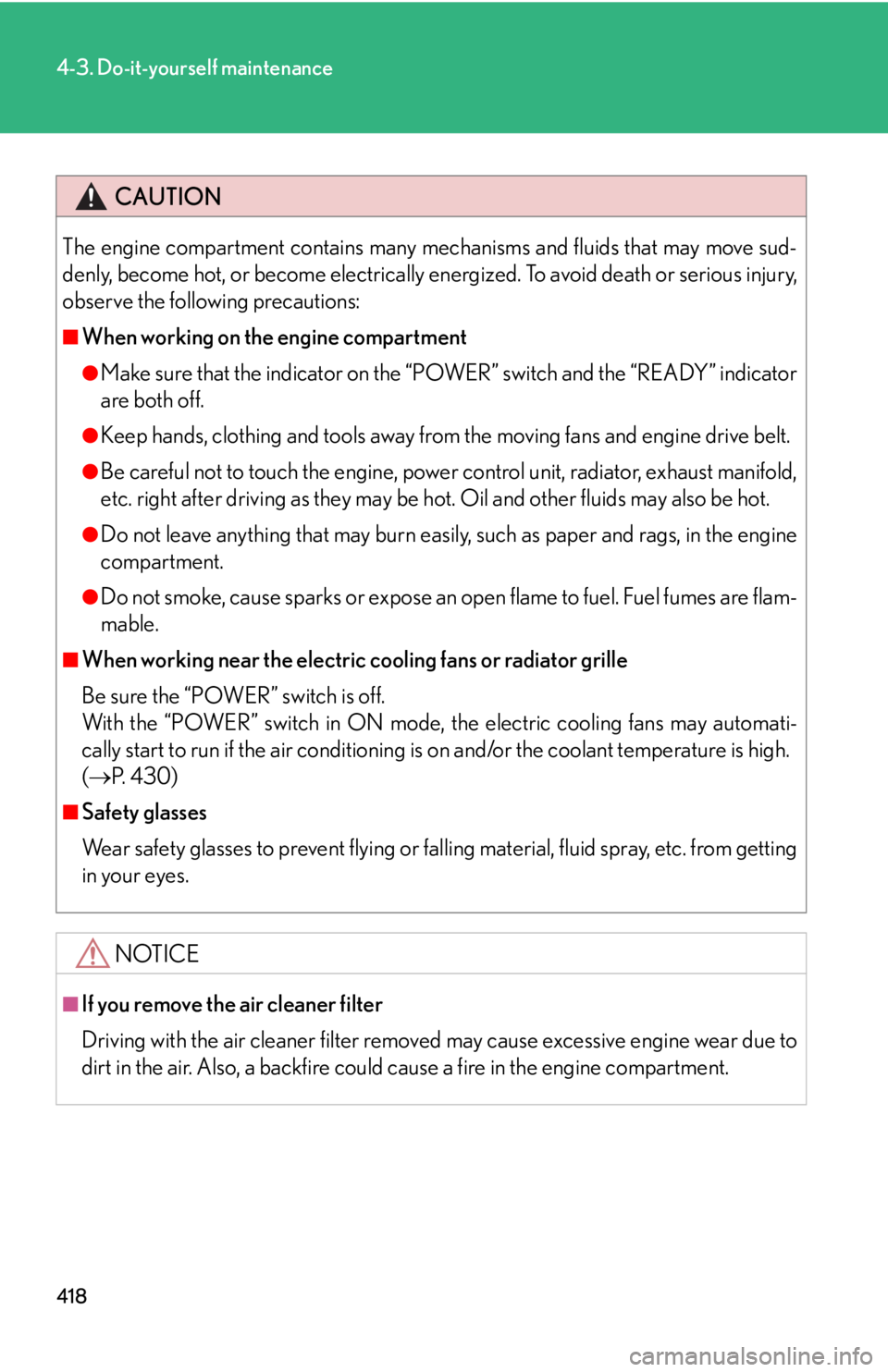
418
4-3. Do-it-yourself maintenance
CAUTION
The engine compartment contains many mechanisms and fluids that may move sud-
denly, become hot, or become electrically energized. To avoid death or serious injury,
observe the following precautions:
■When working on the engine compartment
●Make sure that the indicator on the “POWER” switch and the “READY” indicator
are both off.
●Keep hands, clothing and tools away from the moving fans and engine drive belt.
●Be careful not to touch the engine, power control unit, radiator, exhaust manifold,
etc. right after driving as they may be hot. Oil and other fluids may also be hot.
●Do not leave anything that may burn easily, such as paper and rags, in the engine
compartment.
●Do not smoke, cause sparks or expose an open flame to fuel. Fuel fumes are flam-
mable.
■When working near the electric cooling fans or radiator grille
Be sure the “POWER” switch is off.
With the “POWER” switch in ON mode, the electric cooling fans may automati-
cally start to run if the air conditioning is on and/or the coolant temperature is high.
( P. 4 3 0 )
■Safety glasses
Wear safety glasses to prevent flying or falling material, fluid spray, etc. from getting
in your eyes.
NOTICE
■If you remove the air cleaner filter
Driving with the air cleaner filter removed may cause excessive engine wear due to
dirt in the air. Also, a backfire could cause a fire in the engine compartment.
Page 435 of 608
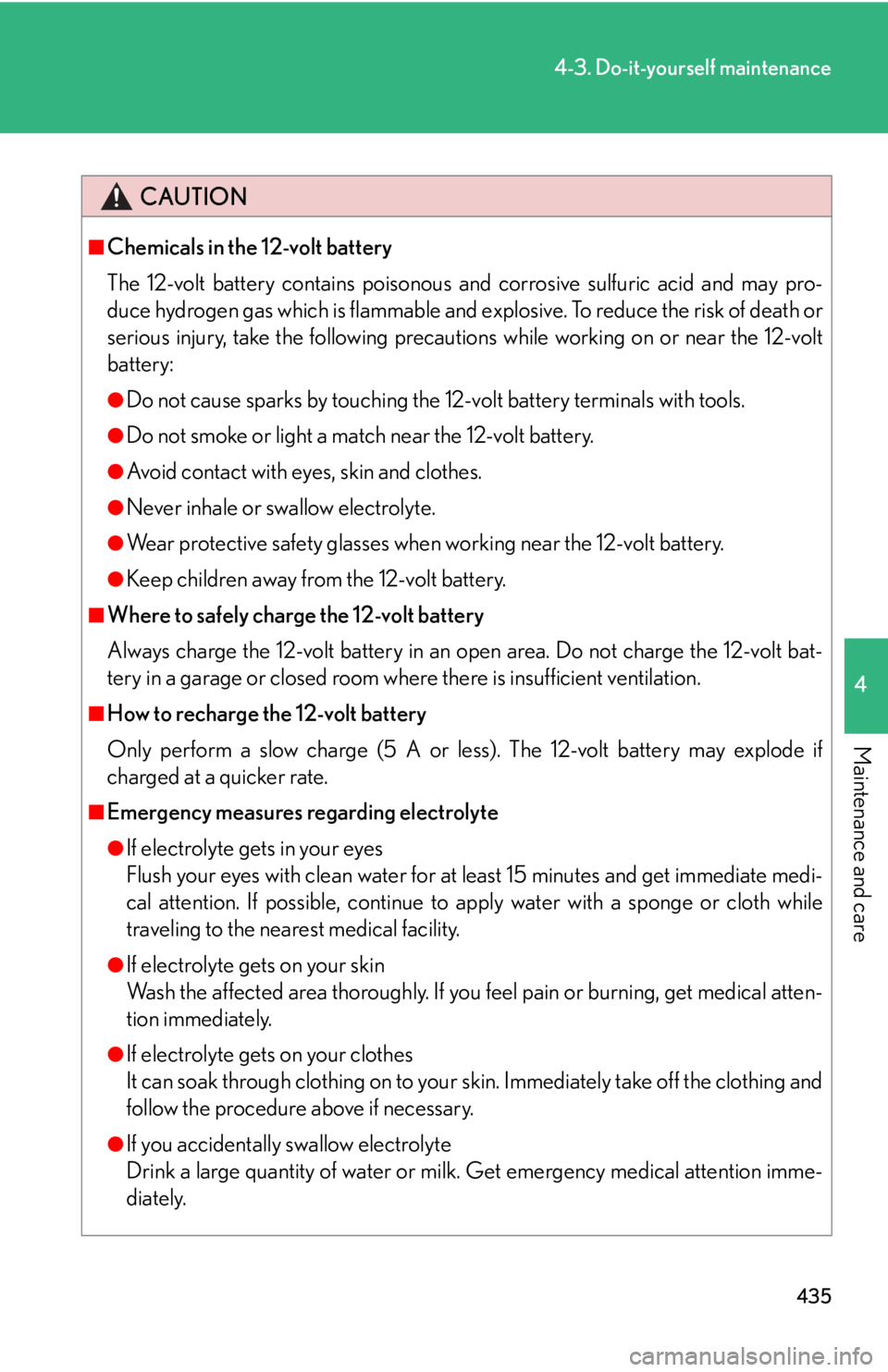
435
4-3. Do-it-yourself maintenance
4
Maintenance and care
CAUTION
■Chemicals in the 12-volt battery
The 12-volt battery contains poisonous and corrosive sulfuric acid and may pro-
duce hydrogen gas which is flammable and explosive. To reduce the risk of death or
serious injury, take the following precautions while working on or near the 12-volt
battery:
●Do not cause sparks by touching the 12-volt battery terminals with tools.
●Do not smoke or light a match near the 12-volt battery.
●Avoid contact with eyes, skin and clothes.
●Never inhale or swallow electrolyte.
●Wear protective safety glasses when working near the 12-volt battery.
●Keep children away from the 12-volt battery.
■Where to safely charge the 12-volt battery
Always charge the 12-volt battery in an open area. Do not charge the 12-volt bat-
tery in a garage or closed room where there is insufficient ventilation.
■How to recharge the 12-volt battery
Only perform a slow charge (5 A or le ss). The 12-volt battery may explode if
charged at a quicker rate.
■Emergency measures regarding electrolyte
●If electrolyte gets in your eyes
Flush your eyes with clean water for at least 15 minutes and get immediate medi-
cal attention. If possible, continue to apply water with a sponge or cloth while
traveling to the nearest medical facility.
●If electrolyte gets on your skin
Wash the affected area thoroughly. If you feel pain or burning, get medical atten-
tion immediately.
●If electrolyte gets on your clothes
It can soak through clothing on to your skin. Immediately take off the clothing and
follow the procedure above if necessary.
●If you accidentally swallow electrolyte
Drink a large quantity of water or milk. Get emergency medical attention imme-
diately.
Page 539 of 608
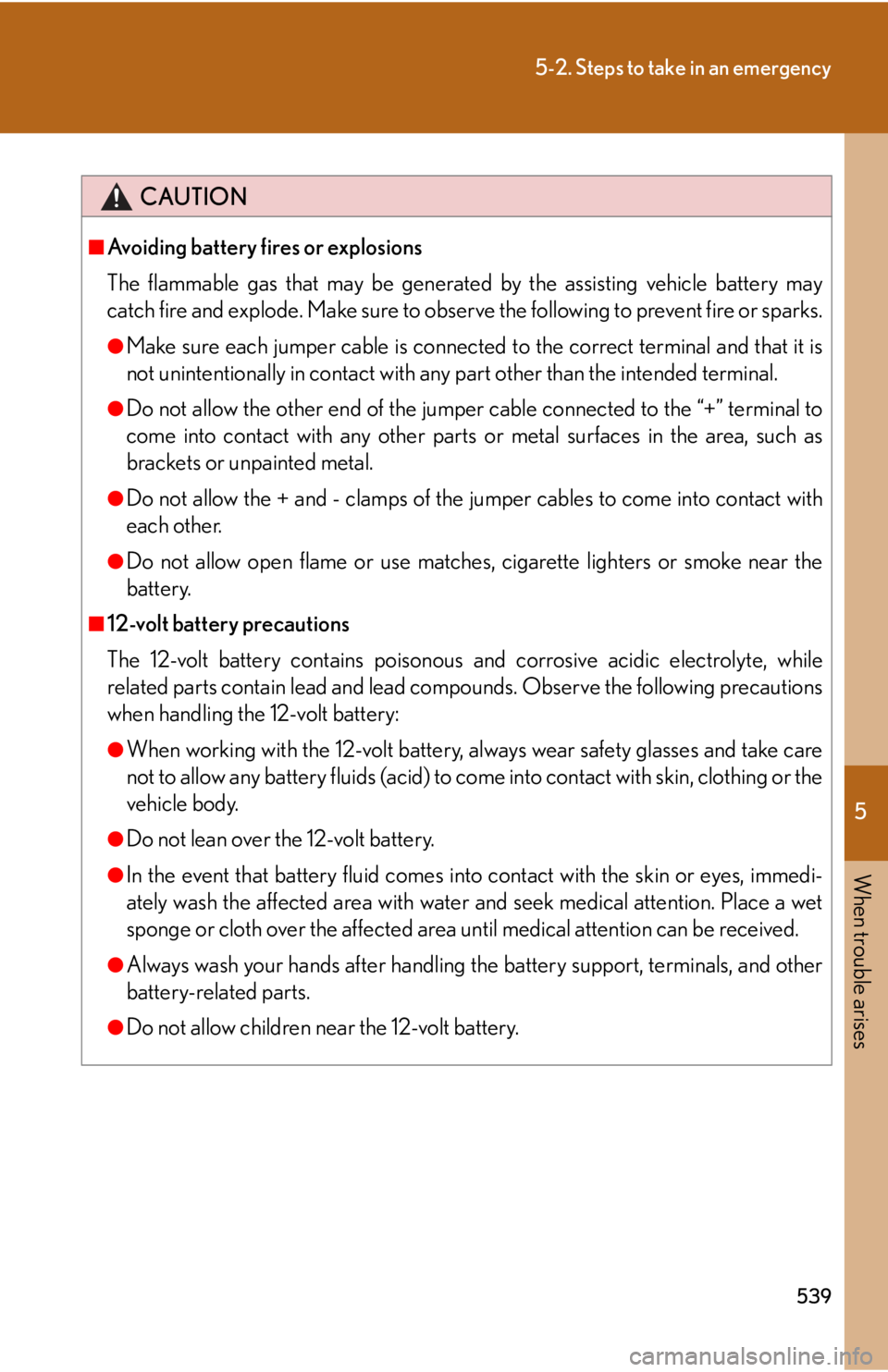
5
When trouble arises
539
5-2. Steps to take in an emergency
CAUTION
■Avoiding battery fires or explosions
The flammable gas that may be generated by the assisting vehicle battery may
catch fire and explode. Make sure to observe the following to prevent fire or sparks.
●Make sure each jumper cable is connected to the correct terminal and that it is
not unintentionally in contact with any part other than the intended terminal.
●Do not allow the other end of the jumper cable connected to the “+” terminal to
come into contact with any other parts or metal surfaces in the area, such as
brackets or unpainted metal.
●Do not allow the + and - clamps of the ju mper cables to come into contact with
each other.
●Do not allow open flame or use matches, cigarette lighters or smoke near the
battery.
■12-volt battery precautions
The 12-volt battery contains poisonous and corrosive acidic electrolyte, while
related parts contain lead and lead comp ounds. Observe the following precautions
when handling the 12-volt battery:
●When working with the 12-volt battery, always wear safety glasses and take care
not to allow any battery fluids (acid) to co me into contact with skin, clothing or the
vehicle body.
●Do not lean over the 12-volt battery.
●In the event that battery fluid comes into contact with the skin or eyes, immedi-
ately wash the affected area with water and seek medical attention. Place a wet
sponge or cloth over the affected area until medical attention can be received.
●Always wash your hands after handling the battery support, terminals, and other
battery-related parts.
●Do not allow children near the 12-volt battery.
Page 552 of 608
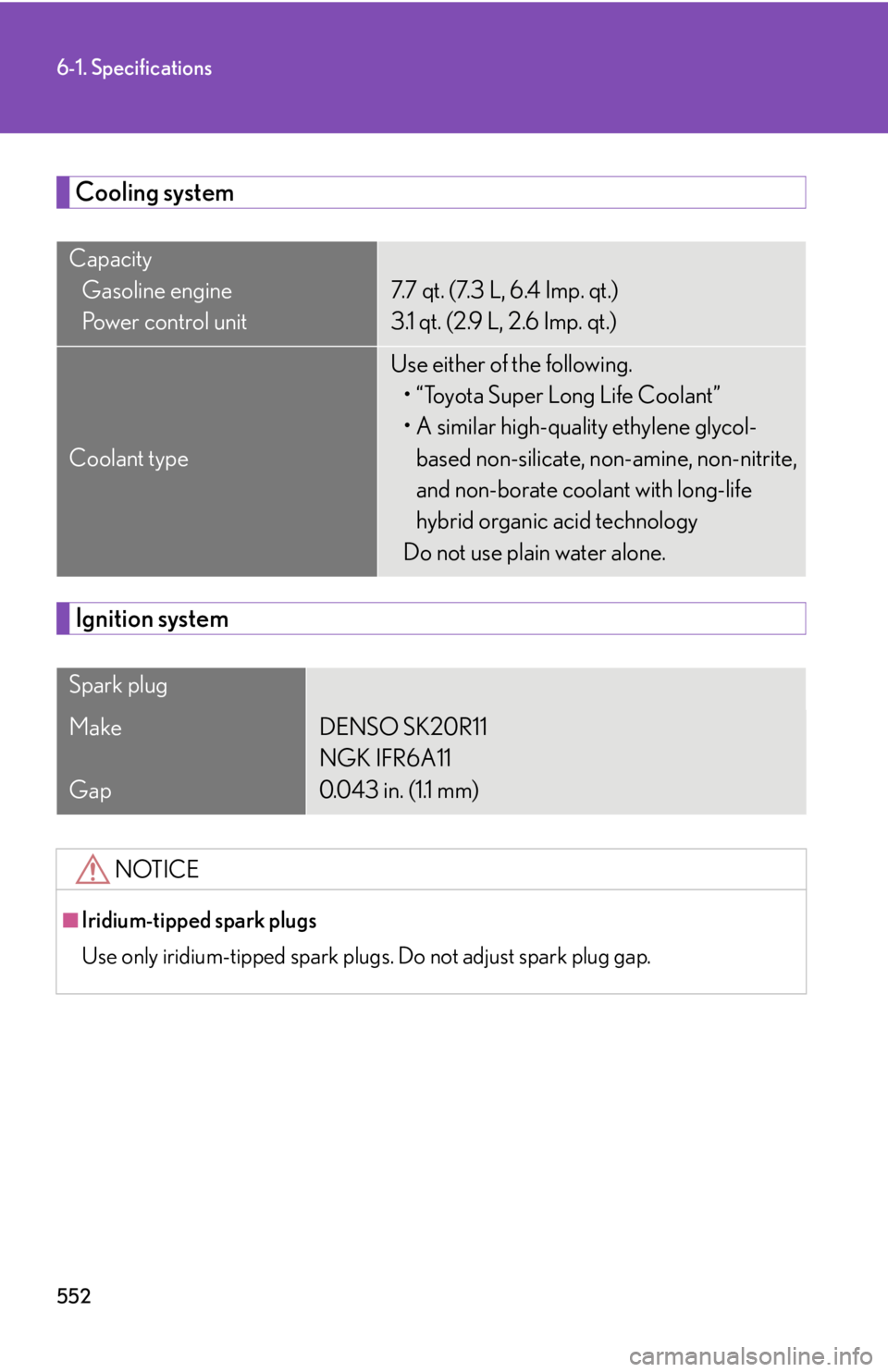
552
6-1. Specifications
Cooling system
Ignition system
CapacityGasoline engine
Power control unit
7.7 qt. (7.3 L, 6.4 Imp. qt.)
3.1 qt. (2.9 L, 2.6 Imp. qt.)
Coolant type
Use either of the following.• “Toyota Super Long Life Coolant”
• A similar high-quality ethylene glycol-
based non-silicate, non-amine, non-nitrite,
and non-borate coolant with long-life
hybrid organic acid technology
Do not use plain water alone.
Spark plug
Make
GapDENSO SK20R11
NGK IFR6A11
0.043 in. (1.1 mm)
NOTICE
■Iridium-tipped spark plugs
Use only iridium-tipped spark plugs. Do not adjust spark plug gap.
Page 600 of 608

600
Alphabetical index
Seat beltsAdjusting the seat belt.........................74
Automatic Locking Retractor ........ 75
Child restraint system
installation ............................................ 124
Cleaning and maintaining
the seat belt ....................................... 407
Emergency Locking Retractor ..... 75
How to wear your seat belt..............73
How your child should wear
the seat belt .......................................... 75
Pre-collision seat belts .................... 232
Pregnant women,
proper seat belt use......................... 75
Reminder light .....................................495
Seat belt extenders .............................. 76
Seat belt pretensioners .......................74
Seat heaters ............................................ 375
Seat position memory ............................68
Seat ventilator ........................................ 375
Seating capacity .................................... 243
Seats Adjustment .................................... 64, 68
Adjustment
precautions ..................................67, 70
Child seats/child restraint
system installation ............................ 124
Cleaning.................................................406
Driver’s seat position
memory.................................................. 68
Head restraint........................................... 71
Properly sitting in the seat ................ 101
Seat heaters .......................................... 375
Seat position memory ........................ 68
Ventilated seats .................................. 375 Service reminder indicators .............165
Shift lever
Transmission.......................................... 155
Side airbags ............................................. 103
Side marker lights Replacing light bulbs ....................... 469
Switch ........................................................ 183
Wattage ................................................. 556
Side mirrors Adjusting and folding ......................... 83
Mirror position memory ................... 68
Side turn signal lights Replacing light bulbs ........................479
Wattage ................................................. 556
Smart access system with
push-button start Antenna location ...................................46
Entry functions ........................................ 44
Starting the engine.............................. 147
Starting the hybrid system .............. 147
Smart entry & start system Antenna location ...................................46
Entry function .......................................... 44
Starting the engine.............................. 147
SOS button ............................................. 395
Spare tire Inflation pressure ............................... 555
Storage location .................................. 521
Spark plug ............................................... 552
Specifications ......................................... 548
Speedometer ...........................................162